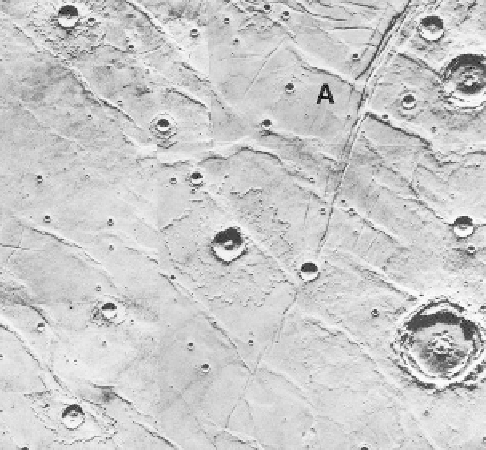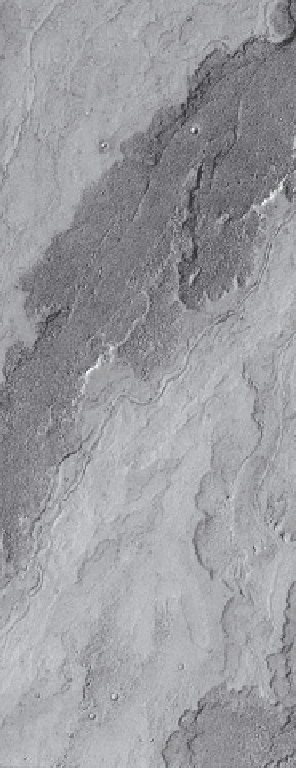Geology Reference
In-Depth Information
These represent the oldest volcanic constructs on Mars,
dating from 3.9 Ga. As the name implies, they occur
primarily in the cratered uplands of Mars with most
paterae in the Circum-Hellas Volcanic Province. The char-
acteristics of the patera
flanks suggest erosion by rela-
tively
remote sensing showing basaltic compositions for the
martian ridged plains, these considerations lend support
to the interpretation that such plains are volcanic. Referred
to as simple
flows in
Table 7.2
, the ridged plains are
considered to represent
flood eruptions that buried their
eruptive
fissures. In contrast, complex
ows are composed
of thin, multiple
flows that form distinctive lobes
(Fig. 7.15)
, many of which were emplaced through lava
tubes and channels. As such, they re
ect lower volumes of
lava and slower rates of effusion than the more massive
simple
flows of the ridged plains. Transitional between the
large shield volcanoes and the lava flows are small shield
volcanoes
(Fig. 7.16)
.
Undifferentiated
ows
(Table 7.2)
constitute much of
the northern lowland plains. Although these plains
involve a wide variety of materials resulting from aeolian,
material, and it has been suggested that
these volcanoes are ash shields from explosive eruptions.
Some paterae appear to have evolved to more effusive
eruptions, as evidenced by superposed lava
ows.
Alba Patera is a huge, unique, very-low-pro
le feature
in the northern part of the Tharsis region. Radial
ows
extend more than 400 km from its central caldera, with
many of the
flows having been emplaced through lava
tubes. Their great length suggests very
fluid lavas, prob-
ably of basaltic or ultra-ma
c compositions. Alba Patera
covers some 1.13 × 10
6
km
2
, nearly equal to all of the
shield volcanoes on Mars combined. Were it not for its
very low relief, many planetary scientists might consider it
the largest single volcano in the Solar System.
Ridged plains are found in many parts of Mars
(Fig. 7.14)
and are very similar to those seen on the
Moon, Mercury, and Venus. Although such ridges are
primarily tectonic features, they are thought to be charac-
teristic of deformed thick basalt
flows. Mare-type ridges
are also seen in materials
filling the
floors of the large
calderas on Mars. Coupled with compositional data from
“
soft
”
Figure 7.14. An image mosaic of ridged plains in the southern
hemisphere; the ridges resemble those seen on the Moon, Mercury,
and Venus; the ridge at
Figure 7.15. Complex lavas in the Arsia Mons area, showing multiple
flow-lobes and lava channels; the area shown is 20 km by 47 km
(NASA THEMIS orbit 35460).
appears to have been offset by right-
lateral displacement by the fracture; most of the craters display
ejecta
flow-lobes (NASA Viking Orbiter 610A01
“
A
”
-
3, 608A09).




